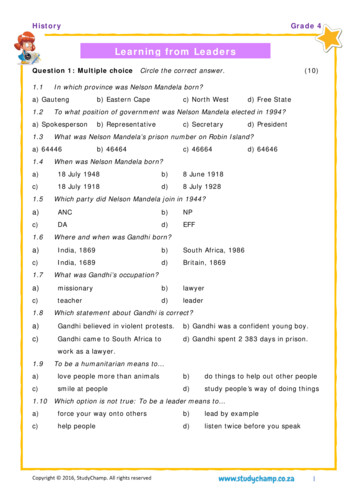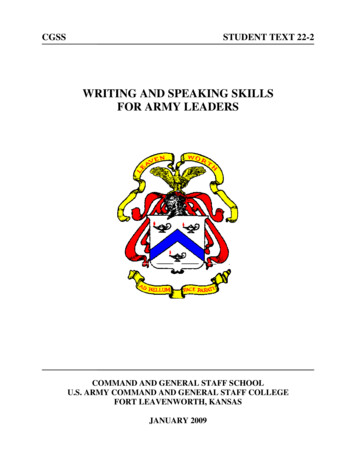
Transcription
Asia Pacific Journal of Marketing & Management Review ISSN 2319-2836Vol.2 (8), August (2013)Online available at indianresearchjournals.comARE LEADERS BORN OR MADE?K.R.SWAROOP*; N.G.A.PRASAD*** RESEARCH SCHOLARSRI VENKATESWARA UNIVERSITYCHITTOOR (DT.)ANDHRA PRADESH**RESEARCH SCHOLARSRI VENKATESWARA UNIVERSITYCHITTOOR (DT.)ANDHRA PRADESHABSTRACTLeadership has paramount importance in present competitive business environment, becausewith the help of leadership a company will face all the problems very efficiently. Leaders are thekey factor that guides and drives an organization in the path of success. Every organization issearching for leaders as their employees. This research paper is an attempt for achieving theseobjectives namely, to study whether the leaders are born or made, to know the importance ofleadership and to analyze the responses of the present young generation towards leadershipconcept that whether leaders are made or born. This study is based on descriptive research designConvenience sampling technique is used for the selection of respondents of 160 (sample size )and primary data is collected with the questionnaire as a tool .The collected and analyzed datareveals that majority of the respondents were opinioned that leaders are made but not born.Therefore, leaders are made as leadership is skill which can be learnt through education,training, continuous practice and experiences.KEY WORDS: Continuous practice, Education, Experiences, Leaders, Skill and Talent.INTRODUCTIONWhat will be tomorrow’s business scenario and what needs to be successful? This is a criticalquestion all the organizations face today .To answer this question, an organization needs leaderswho are effective. Due to highly competitive business world, organizations are searching forleaders as their employees.Research on leadership indicates that 50- 75 % of organizations are currently managed by peoplegreatly lacking in leadership competence. They are hired or promoted based on technicalcompetence, business knowledge and politics not on leadership skill.Before explaining in detail about leadership, it is worthwhile to know whether it is a skill or atalent. If it is a talent, then leadership is an in born quality as talents are intrinsic. If it is a skill,then it can be acquired by rapacious reading, learning, continuous practice, training andexperience. If it is a talent, then the leaders are born and if it is a skill, then the leaders are made.Leadership is more of an action rather than preaching. It is the ability to lead from the front witha passion and with a conviction of a great vision, despite many successive setbacks. It is alsotaking a sense of responsibility, setting as a role model with qualities like courage, commitmentand conviction.35
Asia Pacific Journal of Marketing & Management Review ISSN 2319-2836Vol.2 (8), August (2013)Online available at indianresearchjournals.com ship is all about courage to dream big.' Leadership is all about courage, courage to dream big, to take tough decisions, etc.Second, it is the ability to raise the aspirations of people and third, to be open minded andto accept great ideas from different countries and culture across the world.Leadership is also a way of calling ‘we’ not ‘ I’ because no leader is successful as an individual.Whenever there is a success story, the leader ascribes it to his team and in case of a failure, heowns the sole responsibility .There are many dimensions and definitions to the concept ofleadership. In this paper an attempt is made to study whether the leaders are born or made, toexplore the concept of leadership and to analyze the responses of the present young generationtowards leadership concept that whether leaders are made or born.OBJECTIVES OF THE STUDY To study whether the leaders are born or made, To study the importance of leadership To analyze the responses of the present young generation towards leadership concept thatwhether leaders are made or born.RESEARCH METHODOLOGYThe study relies upon both primary data as well as secondary data. Primary data is collected fromthe MBA students who are studying final semester, Junior business executives and Businessman.The convenience sampling technique is used in this research. Descriptive research design is usedwhich describe the actual behavior of the phenomenon. The questionnaire is the main tool ofcollecting data .The distant respondents are approached by email. The collected data analyzedwith the help of percentages .DISCUSSION OF THE STUDYConcept of leadershipManagers are people who do things right, while leaders are people who do the right thing.The very essence of leadership is that you have to have a vision.Good leaders are made not born. If you have the desire and will power, you can become aneffective leader. Good leaders develop through a never ending process of self –study, education,training, and experience.To inspire your people into higher levels of teamwork, there are certain things you must be,know and do. These do not come naturally, but are acquired through continual work and study.The best leaders are continually working and studying to improve their leadership skills.Before we get started, let's define leadership. Leadership is a complex process by which a personinfluences others to accomplish a mission, task, or objective and directs the organization in away that makes it more cohesive and coherent. A person carries out this process by applying herleadership attributes (belief, values, ethics, character, knowledge, and skills).Although yourposition as a manager, supervisor, lead, etc. gives you the authority to accomplish certain tasksand objectives in the organization, this power does not make you a leader.it simply makes youthe boss. Leadership makes people want to achieve high goals and objectives, while, on the otherhand, bosses tell people to accomplish a task or objective.36
Asia Pacific Journal of Marketing & Management Review ISSN 2319-2836Vol.2 (8), August (2013)Online available at indianresearchjournals.comTwo Most Important keys of leadershipHay's study examined over 75 key components of employee satisfaction. They found that: Trust and confidence in top leadership was the single most reliable predictor of employeesatisfaction in an organization. Effective communication by leadership in three critical areas was the key to winningorganizational trust and confidence: Helping employees understand the company's overall business strategy. Helping employees understand how they contribute to achieving key business objectives. Sharing information with employees on both how the company is doing and how anemployee's own division is doing relative to strategic business objectives. So basically, you must be trustworthy and you have to be able to communicate a vision ofwhere you are going. Notice how the "principles of leadership "in the next section closelyties in with this.The process of great leadershipThe road to great leadership (5) (common to successful leaders): Challenge the process-First; find a process that you believe needs to be improved themost. Inspire a shared vision-Next, share you vision in words that can be understood by yourfollowers. Enable others to act-Give them the tools and methods to solve the problem. Model the way-when the process gets tough, get your hands dirty. A boss tells otherswhat to do a leader shows it can be done. Encourage the heart-Share the glory with your followers' heart, keep the pains in yourheart.Impact of leadership in organizationLeadership and human behaviorAs a leadership, you need to interact with followers, peers, seniors, and other people whosesupport you need to accomplish your objectives. To gain their support, you must be able tounderstand and motivate them. To understand and motivate people, you must know humannature .Human nature is the common qualities of all people have similar needs .As a leader youmust understand these needs because they are powerful motivators.Leadership and CommunicationMany of the problems that occur in a organization are the direct result of people failing tocommunicate. Faulty communication causes the most problems. It leads to confusion and cancause a good plan to fail. Communication is exchange and flow of information and ideas fromone person to another. It involves a sender transmitting an idea to a receiver. Effectivecommunication occurs only if the receiver understands the exact information or idea that thesender intended to transmit.Studying the communication process as important because you coach, coordinate, counsel,evaluate, and supervise through this process. It is the chain of understanding that integrates themembers of an organization from top to bottom, bottom to top, and side to side.37
Asia Pacific Journal of Marketing & Management Review ISSN 2319-2836Vol.2 (8), August (2013)Online available at indianresearchjournals.comLeadership and motivationA person's motivation is a combination of desire and energy directed at achieving a goal.Influencing someone's motivation means getting them to want to do what you know must bedone. A person's motivation depends upon two things:The strength of certain needs. For example, you are hungry, but you must have a Task completedby a nearing deadline. if you are starving you will eat. If you are slightly hungry you will finishthe task at hand.The perception that taking a certain action will help satisfy those needs. For example, you havetwo burning needs-The desire to complete the task and the desire to go to lunch. Your perceptionof how you view those two needs will determine which one takes priority .If you believe that youcould be fired for not completing the task; you will probably put off lunch and complete the task.if you believe that you will not get into trouble or perhaps finish the task in time, then you willlikely go to lunch .LEADERSHIP SECRETS1. DECISIVENESS IS KEY(LALIT KHAITAN, Chairman and Managing Director, Radico khaitan)The most distinguished trait that defines a good leader is the willingness to make decisions thatare need of the hour no matter how difficult they may be. And the most significant component ofsuch decision-making is self-confidence.2.VISIONARY LEADERSHIP(B.MUTHURAMAN, Managing Director, Tata steel)The ability to create a shared vision among team members is the primary trait of a true leader.3. RELATE AND RULE(N.LAKSHMI NARAYAN, CEO AND President, Cognizant Technology Solutions)Good leadership is the ability to recognize all the factors that would make the leader succeed inmotivating the group.4. TAKE RESPONSIBILTY(R.V.SHASTRI, Chairman and Managing Director, Canara bank)A leader is only as good as his team. Leadership involves two steps: helping subordinates takeadvantage of their talents, and then fine tuning their performance. Good leaders always takeresponsibility for both the success and failure of their teams.ANALYSIS OF THE STUDYTable no 1: Respondents classification based on genderSexNo .of RespondentsMale96Female64Total160Source: Primary dataThe above table indicates that 60 percent of the respondents werefemale.Percentage60 %40 %100male and 40 percent were38
Asia Pacific Journal of Marketing & Management Review ISSN 2319-2836Vol.2 (8), August (2013)Online available at indianresearchjournals.comTable no 2: Respondents classification based on ProfessionType of ProfessionNo. of RespondentsMBA students (pursuing final 70semester)Junior Business Executives60Business man30Total160Source: Primary dataPercentage43.75 %37.5 %18.75 %100The table reveals that 43.75 percent of the respondents were MBA students, 37.50 percent werejunior business executives and remaining 18.75 percent were business man.Table no 3: Respondent’s opinion towards whether leaders are born or madeOptionMBA studentsJuniorBusiness Business ManExecutivesB16 ( 10 % )15 (9.375 %)08 (5 %)M33 (20.625 %)30 (18.75 %)17 (10.625 %)T21 (13.125 %)15 (9.375 % )05 (3.125 % )total70 (43.75 %)60 (37.50 %)30 (18.75 % )Source: Primary data(Leaders are born but not made B, Leaders are made but not born M and Leaders areequally born as well as made T)The table reveals that 50 percent of the respondents were opinioned that leaders are made butnot born, 24.375 percent of respondents were opinioned that leaders are born but not made and20.625 percent of respondents were opinioned that leaders are equally born as well as made.Table no 4: Factors that are most important in creating leaderFactorsMBA StudentsJuniorBusiness Business ManExecutivesTraits10 %10 %07 %Education and Training 60 %58 %60 %Experiences30 %32 %33%100 %100 %100 %Source: Primary dataThe table indicates that on average, 60 percent of respondents were opinioned that education andtraining factor is the most important ,next experiences (more than 30 %) and traits are importantin creating a leader.CONCLUSIONLeadership is a skill, not a talent, which can be acquired by education, training, learning,continuous practice and experience. Everyone should know that leaders are not born but aremade due to external environment and circumstances .The road to leadership is not an easy onebut an uphill and a Herculean task. Anybody can become a leader but everybody cannot becomea leader. The leaders lead their lives with lot of struggles and sacrifices and they live larger than39
Asia Pacific Journal of Marketing & Management Review ISSN 2319-2836Vol.2 (8), August (2013)Online available at indianresearchjournals.comlife even after their death because they live more in the hearts of people rather than in the mindsof the people. The leaders inspire and direct their followers to become leaders and achievers. Theleadership is vital for any organization to get high level competence and to achieve industryleadership.REFERENCES1. http://www.businessweek.com/managing/company2. 10/ca20100212 978330.html3. h-blood/4. ing-what-you-pay-for/5. g Leaders StressImportance o f U S Competitiveness BI Mobility ereotype s/8. managing-change-in-the-workplace.html9. nrollment/leadership-developmentprograms/leading-m anaging-people-program.cfm10. Blake, R.; Mouton, J. (1964). The Managerial Grid: The Key to Leadership Excellence.Houston: Gulf Publishing Co.11. Carlyle, Thomas (1841). On Heroes, Hero-Worship, and the Heroic History. Boston, MA:Houghton Mifflin. ISBN 140694419X.12. Fiedler, Fred E. (1967). A theory of leadership effectiveness. McGraw-Hill: Harper and RowPublishers Inc.13.Heifetz, Ronald (1994). Leadership without Easy Answers. Cambridge, MA: HarvardUniversity Press. ISBN 0-674-51858-6.14. Hemphill, John K. (1949). Situational Factors in Leadership. Columbus: Ohio StateUniversity Bureau of Educational Research.15.Montana, Patrick J.; Bruce H. (2008). Management. Hauppauge, New York: Barron'sEducational Series, Inc. ISBN 0944740049.40
Two Most Important keys of leadership Hay's study examined over 75 key components of employee satisfaction. They found that: Trust and confidence in top leadership was the single most reliable predictor of employee satisfaction in an organization. Effective communication by leadershi











